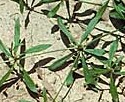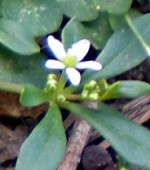 Carpetweed, also called devil’s grip and Indian chickweed, is native to Africa and tropical America but is found in most of the United States and is especially prevalent in the East. A broadleaf summer annual, Indian chickweed grows in disturbed sandy soil of moderate to excellent fertility and is a common problem in garden beds and newly seeded lawns as well as waste areas along roadsides and railroad tracks.
Carpetweed, also called devil’s grip and Indian chickweed, is native to Africa and tropical America but is found in most of the United States and is especially prevalent in the East. A broadleaf summer annual, Indian chickweed grows in disturbed sandy soil of moderate to excellent fertility and is a common problem in garden beds and newly seeded lawns as well as waste areas along roadsides and railroad tracks.

 Description: Seedlings appear as dime-sized rosettes as soon as the soil has warmed in spring but quickly grow into a circular mat forming an extensive carpet over the soil within weeks. The prostrate stems are slender, green, and multibranched with whorls of 3-8 smooth light green leaves at each node. The leaves are egg-shaped to elliptical, .4 to 1.2 “ in length, and taper to a tiny petiole. Clusters of two to five small white flowers are produced on slender stalks at the leaf axis in mid to late summer. Small three-parted egg-shaped fruits contain orange-red seeds. The root system is a fibrous taproot.
Description: Seedlings appear as dime-sized rosettes as soon as the soil has warmed in spring but quickly grow into a circular mat forming an extensive carpet over the soil within weeks. The prostrate stems are slender, green, and multibranched with whorls of 3-8 smooth light green leaves at each node. The leaves are egg-shaped to elliptical, .4 to 1.2 “ in length, and taper to a tiny petiole. Clusters of two to five small white flowers are produced on slender stalks at the leaf axis in mid to late summer. Small three-parted egg-shaped fruits contain orange-red seeds. The root system is a fibrous taproot.

 Control: Mulch discourages growth but carpet weed is easily hand-pulled or hoed especially when the soil is moist. The plant grows and sets seeds quickly so removing it promptly is essential to good control. The best control of severe infestations in lawns can be achieved with repeated applications of products containing at least two of the following active ingredients: 2,4-D, Dicamba, Triclopyr, MCPP, MCPA, MSMA, or quinclorac. Chemical control should be carried out in conjunction with good lawn practices.
Control: Mulch discourages growth but carpet weed is easily hand-pulled or hoed especially when the soil is moist. The plant grows and sets seeds quickly so removing it promptly is essential to good control. The best control of severe infestations in lawns can be achieved with repeated applications of products containing at least two of the following active ingredients: 2,4-D, Dicamba, Triclopyr, MCPP, MCPA, MSMA, or quinclorac. Chemical control should be carried out in conjunction with good lawn practices.